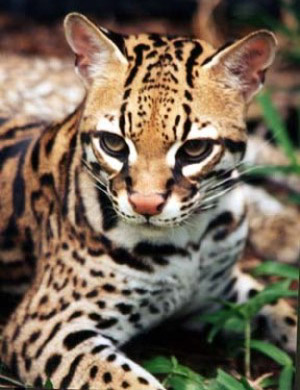|
Weight: 12-30 pounds
Head/Body: 35 inches
Tail: 16 inches
Subspecies: 11
The Ocelot is the typical name, but this cat also has been called 'McNenney's wildcat' "painted leopard" and "tigrillo". They occupy areas in South/Central America, Mexico, the Caribbean and south Texas. It is in fact the largest of the genus Leopardus, and is larger than the Oncilla, which lives in the same habitat.
Ocelots are nocturnal and territorial. A typical Ocelot will fight to the death when threatened, and can be very aggressive if needed. Still, it is a loner by nature, joining another only for mating purposes. Occasionally though, when resting in a tree, it will share its "turf" with another Ocelot of the same sex. These cats are not principally arboreal, but they have the capability. In general however, they are terrestrial animals.
When mating, a female Ocelot will find a place like a bluff or a hollow tree. Gestation lasts about seventy days, and litter size is from 2 to 4 offspring. The ocelot's hunting technique is varied and is carried out mostly by night. Its prey includes small deer, rabbits, rodents, reptiles, and when available, fish. A strong trait of this cat is its vision. Even at night, their sense of sight is very sharp.
Its coat is a soft creamy yellow with striking center-spotted rosettes of black with a soft brown color inside the rosette. The rosettes often link up to form chains. Its head is boldly marked with black spots and bars. Its tail is heavily ringed with a black tip. The fur has a feel very close to a jaguar's, and as such, thousands in the past have been slaughtered. Currently, in the United States, they can be found only in very few areas of Southern Texas.
The Ocelot is listed as Least Concern. It does not qualify for a more at risk category. Widespread and abundant taxa are included in this category, on the IUCN Red List of Threatened Species.

|



